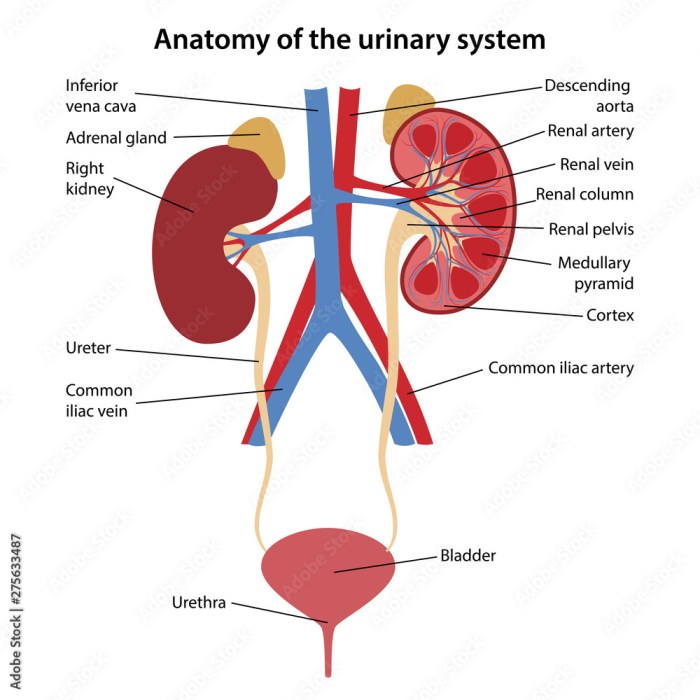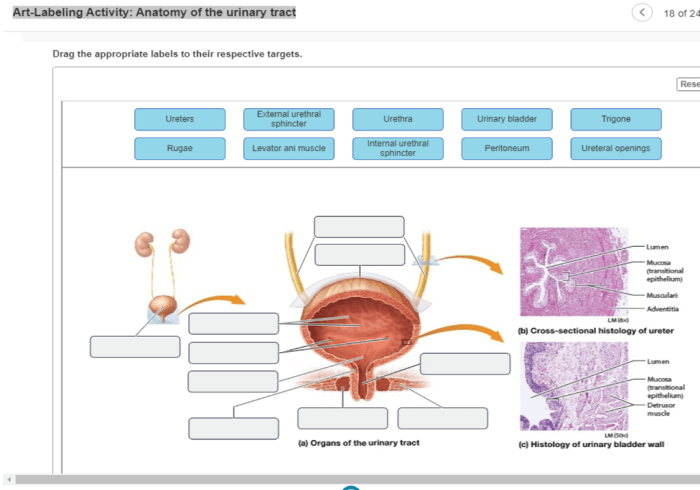Art-labeling activity organs of the urinary system in a female – Embark on an artistic exploration of the female urinary system through an engaging art-labeling activity. This interactive exercise visually represents the anatomical structures, providing a captivating and memorable learning experience.
The activity showcases the intricate network of organs, each performing specialized functions to maintain urinary health. By actively labeling these components, participants gain a deeper understanding of the system’s overall functioning.
Understanding the Urinary System in Females

The female urinary system is a complex network of organs that work together to eliminate waste products from the body and maintain fluid balance. It consists of several key organs, each with specific functions:
- Kidneys:Filter waste products and excess water from the blood, producing urine.
- Ureters:Tubes that transport urine from the kidneys to the bladder.
- Bladder:A muscular sac that stores urine until it is eliminated.
- Urethra:A tube that carries urine from the bladder to the outside of the body.
Art-Labeling Activity: Organs of the Urinary System
To enhance understanding of the female urinary system, an art-labeling activity can be employed. This activity involves:
- Creating a template with unlabeled anatomical structures of the urinary system.
- Providing participants with labels to match with the correct structures.
Step-by-Step s for the Activity
Participants should follow these s to complete the activity:
- Examine the template and identify the unlabeled structures.
- Read the labels provided and determine the correct match for each structure.
- Write or place the label next to the corresponding structure on the template.
- Review their work to ensure accuracy and completeness.
Tips:
- Encourage participants to refer to diagrams or anatomical models for guidance.
- Provide hints or clues if participants encounter difficulties.
Discussion and Analysis
After completing the activity, facilitate a discussion among participants to reinforce their understanding. Encourage them to:
- Share their observations and insights gained from the activity.
- Discuss the functions and relationships between the different organs of the urinary system.
- Explore any misconceptions or gaps in their knowledge.
Assessment and Evaluation
To evaluate participants’ understanding, consider using an assessment method such as:
- A written quiz with multiple-choice or short-answer questions.
- An oral presentation where participants explain the urinary system and its functions.
- A practical test where participants label anatomical structures on a model or diagram.
Criteria for evaluation should focus on accuracy, completeness, and clarity of responses.
Additional Resources and Extensions, Art-labeling activity organs of the urinary system in a female
To supplement the activity and provide further learning opportunities:
- Share educational videos or documentaries on the urinary system.
- Provide access to online simulations or interactive models.
- Assign readings from textbooks or scientific articles on the topic.
Extensions:
- Have participants research and present on specific diseases or disorders related to the urinary system.
- Incorporate the activity into a larger lesson on the human body systems.
- Use the activity as a basis for a creative project, such as creating a poster or model of the urinary system.
General Inquiries: Art-labeling Activity Organs Of The Urinary System In A Female
What is the purpose of the art-labeling activity?
The art-labeling activity aims to provide a visually engaging and interactive way to learn about the organs of the female urinary system, enhancing understanding and retention.
What are the benefits of using art in teaching anatomy?
Art-based learning in anatomy offers several benefits, including improved visual memory, enhanced spatial reasoning, and increased motivation and engagement.

